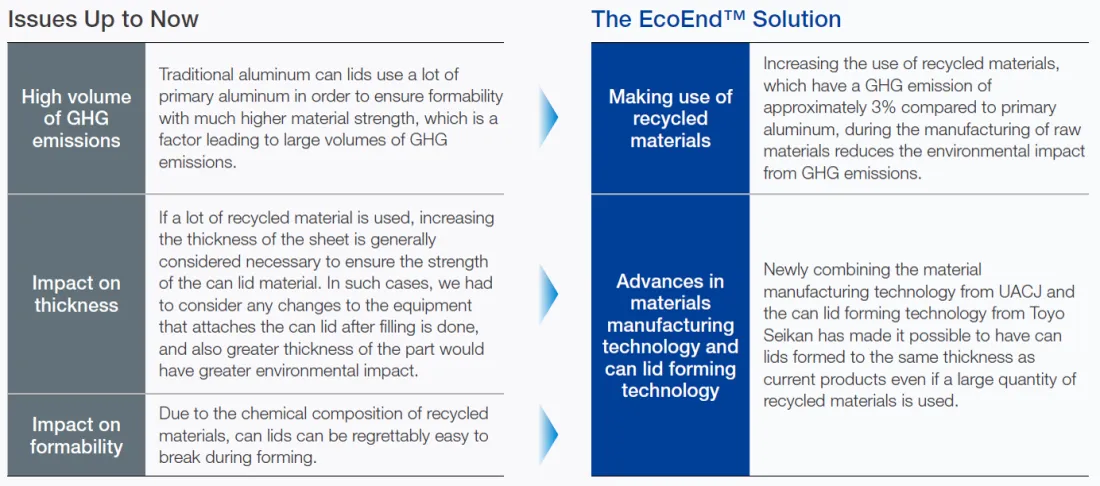EcoEnd™ is a next-generation beverage can lid that makes a significant reduction in its environmental impact by increasing the proportion of recycled materials. Toyo Seikan Co., Ltd. developed it jointly with UACJ Corporation. While keeping quality at the same level as for current products, its dramatic reduction in GHG emissions has enabled the product to make a large contribution to achieving a sustainable society.
EcoEnd™ makes a significant reduction in GHG emissions while also achieving the same functionality as traditional can lids. Whereas traditional can lids make heavy use of primary aluminum, the EcoEnd™ manufacturing process makes a
large cut to GHG emissions. The product substantially increases the proportion of recycled materials, such as used beverage cans (UBCs), and as a result reduces GHG emissions by approximately 40% compared to traditional can lids, thereby making it possible to achieve a large reduction in environmental impact.
A beverage is composed of a can body and can lids, which in order to perform their respective functions use special materials with different properties. Because can lids require formability with greater material strength than the body of the can, it is difficult to find uses for UBCs, which leads to a requirement for large quantities of primary aluminum. The GHG emissions factor of can lids is therefore unusually high̶at least twice as large as materials for the body of the can.
EcoEnd™ increases the volume of recycled materials used, and thus can reduce GHG emissions by about 40% compared to traditional can lids to the order of
13,000 tons per billion can lids. If all can lids sold by Toyo Seikan in Japan were replaced by EcoEnd™, an estimated annual reduction of approximately 140,000
tons in GHG emissions. In CO2 absorption, this is the equivalent of what 10 million cedar trees would absorb in one year.
Because the strength and other characteristics required for the lid and body of the can are different, a certain amount of primary aluminum needs to be used for the lid, and the composition needs to be adjusted. The material in EcoEnd™ reduces the use of primary aluminum and increases the proportion of recycled
materials so that it matches the can body more closely. Therefore, at the point of melting, the material of EcoEnd™ and the can body can be considered the
same mono-material. After it melts, the composition can be adjusted, and the characteristics of the can lid and can body can be differentiated.
The development of EcoEnd™ has made it possible to circulate a large amount of recycled materials in the can lid, which was previously challenging, through
postmelting composition adjustment and manufacturing techniques. In the future, more recycled materials will be used in the lid, leading to a reduction in GHG emissions due to the decrease in primary aluminum usage.
EcoEnd™ keeps the thickness the same as in current can lids, which makes equipment changes on the filling line unnecessary. This means that the switchover will be smooth and environmental impact will be lessened because the existing production facilities can be used the same way they are now.
As of September 2024, the EcoEnd™ production system has been set up in Japan, and we are getting ready for mass production for customer use.
The Toyo Seikan Group will continue to travel its path to technology innovation and to focus its efforts in the realization of a sustainable society.
- [2024.11.18 Press Release] Toyo Seikan and UACJ's Next-Generation Aluminum Beverage EcoEnd™ Can Lid Wins Three Awards at The Canmaker Cans of the Year Awards 2024
- [2024.7.9 Press Release] Completion of the mass production system for "EcoEnd™," the Next-Generation Beverage Can Lid, Which Achieves a 40% Reduction in Greenhouse Gas Emissions - A Collaborative Effort by UACJ and Toyo Seikan -
- [2023.12.4 Press Release] Development of Next-Generation Eco-Friendly Can Lid 'EcoEnd™' with Major Revisions to Materials and Manufacturing Methods - Joint efforts by Toyo Seikan and UACJ reduce greenhouse gas emissions by 40%





